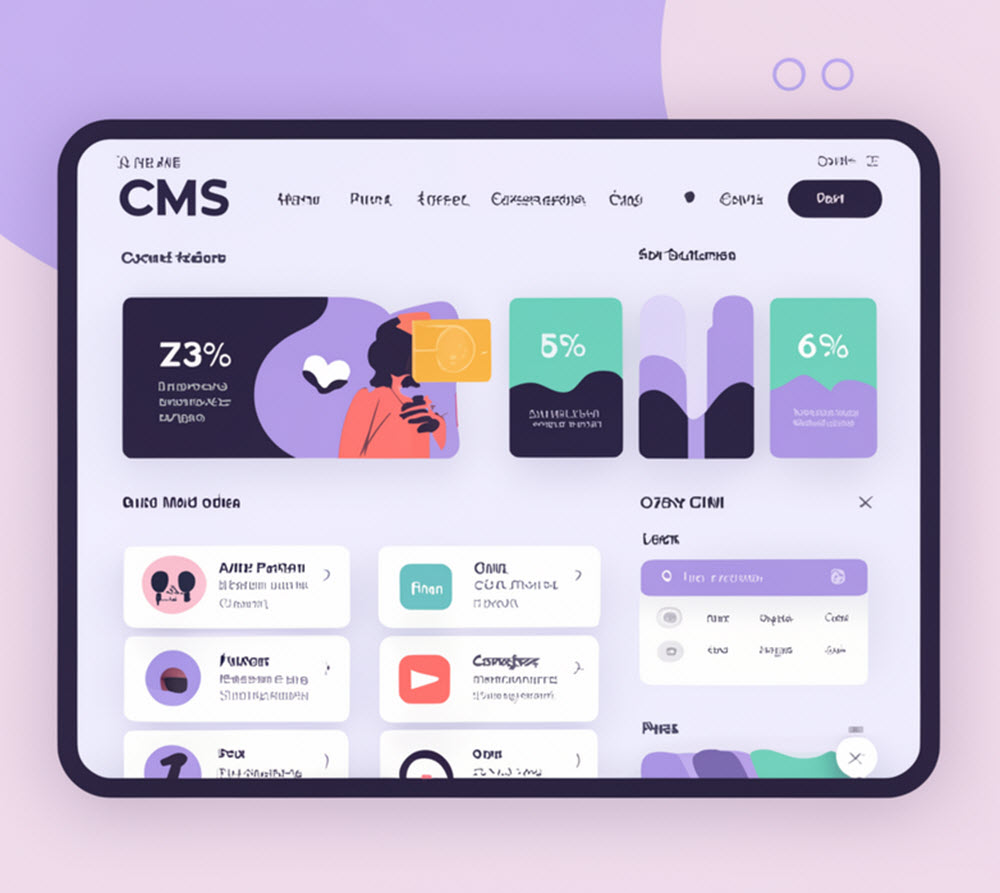Content Management Systems (CMS) are software applications designed to create, manage, and modify digital content without the need for specialized technical knowledge. Essentially, a CMS provides a user-friendly interface that simplifies the web development process, allowing individuals and organizations to publish, edit, and organize content on websites more efficiently. This can include text, images, video, and audio elements, making CMS platforms versatile tools for managing a wide range of digital content.
Content Management Systems have democratized web development, enabling individuals and businesses to manage their online presence effectively without deep technical knowledge. By providing tools for content creation, management, and optimization, CMS platforms play a crucial role in the digital landscape, empowering users to build and maintain dynamic, engaging websites.

Key Features of a CMS
User-Friendly Interface: A CMS typically features an intuitive dashboard that allows users to create and manage content easily, even without coding skills.
Content Creation and Editing: Users can create and format content, insert media, and preview changes before publishing, all within a straightforward editor.
Template-based Design: Most CMS platforms offer a selection of templates or themes that define the visual appearance of the website, which can be customized to fit the user’s preferences or brand identity.
Content Organization: A CMS helps in categorizing and tagging content, making it easier to manage, search for, and reuse.
User Roles and Permissions: Administrators can assign roles and permissions to different users, controlling who can view, create, edit, and publish content.
SEO Tools: Many CMS platforms include built-in tools or add-ons to optimize content for search engines, enhancing the site’s visibility online.
Extensibility: Plugins or extensions can add new features and functionalities to a CMS, allowing customization to meet specific needs.
Choosing a CMS
Selecting the right CMS depends on several factors, including the website’s purpose, the technical expertise of the users, budget constraints, and specific feature requirements. Considerations should include the CMS’s ease of use, customization capabilities, security features, community and support, and overall cost (including any subscription fees or costs associated with extensions and themes).
Examples of Popular CMS Platforms
WordPress
This is th-e most widely used CMS globally, known for its ease of use, flexibility, and extensive plugin ecosystem. It powers a significant portion of the internet’s websites, from blogs to complex corporate sites.
Founded by the U.S. Developer Matt Mullenweg and the British developer Mike Little, WordPress was launched in May 2003. In December 2023, WordPress was used by over 43% of the top 10 million websites.
WordPress was originally create for publishing blogs, but is today used to publish and manage a wide range of web content, including traditional web sites, membership sites, online forums, online shops, and mailing lists.
WordPress is available as free and open-source software. WordPress, WordPress Projects and other related trademarks are owned by the WordPress Foundation.
WordPress is written in PHP hypertext preprocessor language and paired with a MySQL or MariaDB database. To work, it needs to be installed on a web server (a computer runing the WP software package can be the server for smaller sites). Users can utilize a wide variety of templates and plug-ins to create and modify their sites.
Shopify
A specialized CMS for e-commerce websites, providing tools and features tailored for online stores, including inventory management, payment integration, and customer shipping options.
Squarespace
A user-friendly platform that combines CMS functionalities with website building and hosting services. It’s known for its sleek design templates and all-in-one approach.
Joomla
This is a powerful, flexible platform suitable for a wide range of websites. It offers extensive customization options through extensions and templates.
As of 2022, Joomla was the 5th most used CMS on the Internet, after WordPress, Shopify, Wix, and Squarespace.
Joomla (abbreviated J!) is a free and open-source CSM for publishing web content och websites. It is for instance used for traditional web sites, online stores, forums, and user communites.
Joomla is written in PHF and uses both object-oriented programming techniques and software design patterns. This CMS was developed by volunteers supported by Open Source Matters Inc. Data is stored in Structured Query Language (MySQL) database.
Joomla is built on a model-view-controller web application framework which can be used independently of the CSM.
Examples of Joomla features are page caching, blogs, search, and RSS feeds. Users get access to circa 6,000 extensions at the Joomla web site, and extensions are also available from independent sources.
Drupal
Known for its robustness and scalability, Drupal is a preferred choice for complex, high-traffic websites and web applications, including many governmental and corporate sites. It offers a high degree of customization through modules.
Drupal is a free and open-source web CMS distributed under the GNU General Public License. It is written in PHP.
The standard release of Drupal is called Drupal Core.
Drupal offers advanced and complex API for developers, but using Drupal for basic web site installations does not require programming skills.
Drupal was created by Dries Buytaert as a message board for his friend group, to make it easier for them to communicate from their dorms at the University of Antwerp.